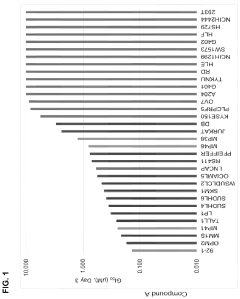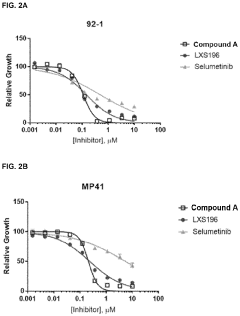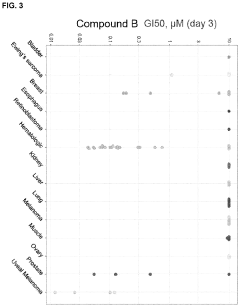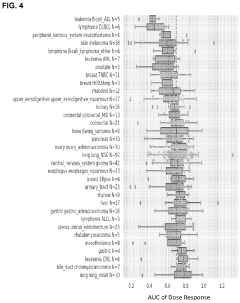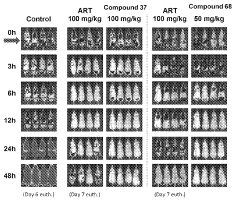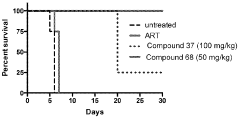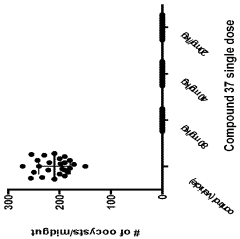Geometric Isomers' Role in Protein Folding and Misfolding Mechanisms
AUG 1, 20259 MIN READ
Generate Your Research Report Instantly with AI Agent
Patsnap Eureka helps you evaluate technical feasibility & market potential.
Protein Folding Isomer Background
Protein folding is a fundamental process in molecular biology, crucial for the proper functioning of cells and organisms. The study of geometric isomers in protein folding has gained significant attention in recent years due to its profound implications for understanding protein structure and function. Geometric isomers, also known as configurational isomers, are molecules with the same molecular formula but different spatial arrangements of atoms.
In the context of protein folding, geometric isomers play a critical role in determining the three-dimensional structure of proteins. The most common type of geometric isomerism in proteins involves the peptide bond, which can exist in either a cis or trans configuration. While the trans configuration is energetically favored and predominates in most proteins, the presence of cis peptide bonds can significantly impact the folding process and final protein structure.
The importance of geometric isomers in protein folding became apparent through pioneering studies on proline residues. Proline is unique among amino acids due to its cyclic side chain, which allows for a higher probability of cis-trans isomerization. This isomerization can act as a rate-limiting step in protein folding, influencing both the kinetics and thermodynamics of the process.
Research has shown that the interconversion between cis and trans isomers can lead to local conformational changes that propagate through the protein structure, affecting its overall stability and function. This phenomenon has been observed in various proteins, including enzymes, signaling molecules, and structural proteins.
The study of geometric isomers in protein folding has also shed light on protein misfolding mechanisms, which are implicated in numerous diseases, such as Alzheimer's, Parkinson's, and various amyloidoses. Misfolding events can sometimes be traced back to improper isomerization of specific peptide bonds, leading to aberrant protein conformations and aggregation.
Advances in experimental techniques, such as nuclear magnetic resonance (NMR) spectroscopy and X-ray crystallography, have enabled researchers to detect and characterize geometric isomers in proteins with unprecedented precision. These methods have revealed the dynamic nature of isomerization processes and their impact on protein folding landscapes.
Computational approaches have also contributed significantly to our understanding of geometric isomers in protein folding. Molecular dynamics simulations and advanced modeling techniques have allowed scientists to explore the energy landscapes associated with different isomeric states and predict their effects on folding pathways.
In the context of protein folding, geometric isomers play a critical role in determining the three-dimensional structure of proteins. The most common type of geometric isomerism in proteins involves the peptide bond, which can exist in either a cis or trans configuration. While the trans configuration is energetically favored and predominates in most proteins, the presence of cis peptide bonds can significantly impact the folding process and final protein structure.
The importance of geometric isomers in protein folding became apparent through pioneering studies on proline residues. Proline is unique among amino acids due to its cyclic side chain, which allows for a higher probability of cis-trans isomerization. This isomerization can act as a rate-limiting step in protein folding, influencing both the kinetics and thermodynamics of the process.
Research has shown that the interconversion between cis and trans isomers can lead to local conformational changes that propagate through the protein structure, affecting its overall stability and function. This phenomenon has been observed in various proteins, including enzymes, signaling molecules, and structural proteins.
The study of geometric isomers in protein folding has also shed light on protein misfolding mechanisms, which are implicated in numerous diseases, such as Alzheimer's, Parkinson's, and various amyloidoses. Misfolding events can sometimes be traced back to improper isomerization of specific peptide bonds, leading to aberrant protein conformations and aggregation.
Advances in experimental techniques, such as nuclear magnetic resonance (NMR) spectroscopy and X-ray crystallography, have enabled researchers to detect and characterize geometric isomers in proteins with unprecedented precision. These methods have revealed the dynamic nature of isomerization processes and their impact on protein folding landscapes.
Computational approaches have also contributed significantly to our understanding of geometric isomers in protein folding. Molecular dynamics simulations and advanced modeling techniques have allowed scientists to explore the energy landscapes associated with different isomeric states and predict their effects on folding pathways.
Market Demand Analysis
The market demand for understanding geometric isomers' role in protein folding and misfolding mechanisms has been steadily increasing in recent years. This growing interest is driven by the critical importance of protein folding in various biological processes and its implications for human health and disease. The pharmaceutical industry, in particular, has shown a keen interest in this field, as protein misfolding is associated with numerous neurodegenerative disorders such as Alzheimer's, Parkinson's, and Huntington's diseases.
Research institutions and biotechnology companies are investing heavily in technologies that can elucidate the intricate mechanisms of protein folding and misfolding. The global protein engineering market, which encompasses research into protein folding, is projected to grow significantly in the coming years. This growth is fueled by the increasing prevalence of protein-based drugs and the need for more efficient and stable protein therapeutics.
The food and beverage industry is another sector showing interest in this field, particularly in the development of functional foods and nutraceuticals. Understanding protein folding mechanisms can lead to improvements in the stability and bioavailability of protein-based ingredients, enhancing their nutritional value and shelf life.
In the materials science sector, insights into protein folding mechanisms are driving innovations in biomaterials and nanotechnology. Companies are exploring the potential of self-assembling proteins for creating novel materials with applications in tissue engineering, drug delivery systems, and biosensors.
The academic research community continues to be a significant driver of demand in this field. Universities and research institutes worldwide are dedicating substantial resources to unraveling the complexities of protein folding and misfolding. This academic interest translates into a growing market for advanced research tools and technologies, including high-resolution imaging systems, computational modeling software, and specialized laboratory equipment.
The biotechnology sector is also capitalizing on advancements in understanding protein folding mechanisms. Companies are developing innovative approaches to protein engineering, aiming to create more stable and effective enzymes for industrial applications. This has implications for various industries, including biofuel production, waste management, and sustainable manufacturing processes.
As the field progresses, there is an increasing demand for interdisciplinary expertise. This has led to a growing market for specialized training programs and educational resources focused on protein folding and related areas of structural biology. The convergence of biology, chemistry, physics, and computational sciences in this field is creating new job opportunities and driving the need for skilled professionals.
Research institutions and biotechnology companies are investing heavily in technologies that can elucidate the intricate mechanisms of protein folding and misfolding. The global protein engineering market, which encompasses research into protein folding, is projected to grow significantly in the coming years. This growth is fueled by the increasing prevalence of protein-based drugs and the need for more efficient and stable protein therapeutics.
The food and beverage industry is another sector showing interest in this field, particularly in the development of functional foods and nutraceuticals. Understanding protein folding mechanisms can lead to improvements in the stability and bioavailability of protein-based ingredients, enhancing their nutritional value and shelf life.
In the materials science sector, insights into protein folding mechanisms are driving innovations in biomaterials and nanotechnology. Companies are exploring the potential of self-assembling proteins for creating novel materials with applications in tissue engineering, drug delivery systems, and biosensors.
The academic research community continues to be a significant driver of demand in this field. Universities and research institutes worldwide are dedicating substantial resources to unraveling the complexities of protein folding and misfolding. This academic interest translates into a growing market for advanced research tools and technologies, including high-resolution imaging systems, computational modeling software, and specialized laboratory equipment.
The biotechnology sector is also capitalizing on advancements in understanding protein folding mechanisms. Companies are developing innovative approaches to protein engineering, aiming to create more stable and effective enzymes for industrial applications. This has implications for various industries, including biofuel production, waste management, and sustainable manufacturing processes.
As the field progresses, there is an increasing demand for interdisciplinary expertise. This has led to a growing market for specialized training programs and educational resources focused on protein folding and related areas of structural biology. The convergence of biology, chemistry, physics, and computational sciences in this field is creating new job opportunities and driving the need for skilled professionals.
Isomer Challenges in Folding
Geometric isomers present significant challenges in protein folding mechanisms, particularly in understanding and predicting the three-dimensional structures of proteins. These isomers, which have the same molecular formula but different spatial arrangements of atoms, can dramatically influence the folding process and ultimately the protein's function.
One of the primary challenges is the complexity introduced by cis-trans isomerism of peptide bonds. While the majority of peptide bonds in proteins adopt the trans configuration, the presence of even a single cis peptide bond can significantly alter the protein's folding pathway and final structure. This isomerization process is often rate-limiting in protein folding, as the energy barrier for cis-trans interconversion is substantial.
The presence of proline residues further complicates the folding landscape. Proline is unique among amino acids in its ability to form both cis and trans isomers with relatively similar energies. This characteristic leads to local conformational heterogeneity and can create kinetic traps during the folding process, potentially resulting in misfolded intermediates or aggregates.
Another challenge lies in the impact of geometric isomers on long-range interactions within proteins. The spatial orientation of side chains, influenced by isomerization, can affect the formation of crucial non-covalent interactions such as hydrogen bonds, salt bridges, and hydrophobic contacts. These interactions are essential for stabilizing the native protein structure, and their disruption due to isomeric variations can lead to misfolding or alternative folding pathways.
The dynamic nature of isomerization during the folding process adds another layer of complexity. As proteins fold, they may undergo multiple isomerization events, creating a vast number of potential conformational states. This multiplicity of states makes it challenging to predict and model the folding pathway accurately, as traditional computational methods often struggle to capture these rapid isomeric transitions.
Furthermore, the influence of geometric isomers on protein aggregation and amyloid formation is a critical area of concern. Misfolded proteins resulting from isomeric challenges can expose hydrophobic regions or form abnormal intermolecular interactions, leading to the formation of toxic aggregates implicated in various neurodegenerative diseases.
Addressing these isomer-related challenges requires a multifaceted approach. Advanced experimental techniques such as time-resolved spectroscopy and single-molecule studies are crucial for capturing the dynamics of isomerization during folding. Computational methods, including molecular dynamics simulations with specialized force fields, are being developed to better model isomeric transitions and their effects on protein structure.
One of the primary challenges is the complexity introduced by cis-trans isomerism of peptide bonds. While the majority of peptide bonds in proteins adopt the trans configuration, the presence of even a single cis peptide bond can significantly alter the protein's folding pathway and final structure. This isomerization process is often rate-limiting in protein folding, as the energy barrier for cis-trans interconversion is substantial.
The presence of proline residues further complicates the folding landscape. Proline is unique among amino acids in its ability to form both cis and trans isomers with relatively similar energies. This characteristic leads to local conformational heterogeneity and can create kinetic traps during the folding process, potentially resulting in misfolded intermediates or aggregates.
Another challenge lies in the impact of geometric isomers on long-range interactions within proteins. The spatial orientation of side chains, influenced by isomerization, can affect the formation of crucial non-covalent interactions such as hydrogen bonds, salt bridges, and hydrophobic contacts. These interactions are essential for stabilizing the native protein structure, and their disruption due to isomeric variations can lead to misfolding or alternative folding pathways.
The dynamic nature of isomerization during the folding process adds another layer of complexity. As proteins fold, they may undergo multiple isomerization events, creating a vast number of potential conformational states. This multiplicity of states makes it challenging to predict and model the folding pathway accurately, as traditional computational methods often struggle to capture these rapid isomeric transitions.
Furthermore, the influence of geometric isomers on protein aggregation and amyloid formation is a critical area of concern. Misfolded proteins resulting from isomeric challenges can expose hydrophobic regions or form abnormal intermolecular interactions, leading to the formation of toxic aggregates implicated in various neurodegenerative diseases.
Addressing these isomer-related challenges requires a multifaceted approach. Advanced experimental techniques such as time-resolved spectroscopy and single-molecule studies are crucial for capturing the dynamics of isomerization during folding. Computational methods, including molecular dynamics simulations with specialized force fields, are being developed to better model isomeric transitions and their effects on protein structure.
Current Isomer Detection Methods
01 Geometric isomers in protein structure
Geometric isomers play a crucial role in protein structure and function. These isomers can affect the folding process and the final conformation of proteins. Understanding the relationship between geometric isomers and protein folding can provide insights into protein stability and potential misfolding issues.- Geometric isomers in protein structure: Geometric isomers play a crucial role in protein structure and folding. These isomers, which have the same molecular formula but different spatial arrangements, can significantly impact the three-dimensional structure of proteins. Understanding the relationship between geometric isomers and protein folding can provide insights into protein function and potential misfolding issues.
- Protein folding mechanisms and chaperones: Protein folding is a complex process involving various mechanisms and molecular chaperones. These chaperones assist in the correct folding of proteins, preventing misfolding and aggregation. Research in this area focuses on understanding the role of chaperones in maintaining protein homeostasis and developing therapeutic strategies to address protein misfolding disorders.
- Protein misfolding and disease: Protein misfolding is associated with various neurodegenerative and other diseases. When proteins fail to fold correctly or maintain their proper structure, it can lead to the formation of toxic aggregates and cellular dysfunction. Studying the mechanisms of protein misfolding and its relationship to disease progression is crucial for developing targeted therapies.
- Analytical techniques for studying protein folding: Advanced analytical techniques are employed to study protein folding and misfolding processes. These methods include spectroscopic techniques, computational modeling, and high-resolution imaging. Such tools allow researchers to observe and analyze protein folding dynamics, identify intermediate states, and characterize misfolded structures.
- Therapeutic approaches targeting protein folding: Developing therapeutic strategies to address protein folding and misfolding issues is an active area of research. Approaches include small molecule modulators, gene therapy, and targeted protein degradation. These interventions aim to promote correct protein folding, prevent aggregation, or eliminate misfolded proteins to treat various protein folding-related disorders.
02 Protein folding mechanisms and chaperones
The process of protein folding involves complex mechanisms and often requires assistance from molecular chaperones. These chaperones help guide the folding process and prevent misfolding. Research in this area focuses on understanding the role of chaperones and developing strategies to enhance proper protein folding.Expand Specific Solutions03 Protein misfolding and associated diseases
Protein misfolding can lead to various diseases, including neurodegenerative disorders. Studying the causes and consequences of protein misfolding is crucial for developing therapeutic approaches. This includes investigating the role of specific amino acid sequences and environmental factors in misfolding events.Expand Specific Solutions04 Analytical techniques for studying protein folding
Advanced analytical techniques are essential for studying protein folding and misfolding. These methods include spectroscopic techniques, computational modeling, and high-resolution imaging. Developing and improving these techniques allows for better understanding of protein folding dynamics and the detection of misfolded structures.Expand Specific Solutions05 Therapeutic approaches targeting protein folding
Developing therapeutic approaches that target protein folding and misfolding is an active area of research. This includes designing small molecules that can stabilize properly folded proteins, prevent misfolding, or promote the clearance of misfolded proteins. Such approaches have potential applications in treating various protein folding-related diseases.Expand Specific Solutions
Key Players in Proteomics
The field of geometric isomers' role in protein folding and misfolding mechanisms is in a developing stage, with significant potential for growth. The market size is expanding as researchers recognize the importance of understanding these processes for various diseases. Technologically, the area is advancing rapidly, with key players like Oxford University Innovation, Genentech, and Novartis AG leading research efforts. Universities such as the University of Milan and KU Leuven are contributing valuable academic insights. The involvement of major pharmaceutical companies indicates the field's commercial potential, while research institutions like CNRS and VIB are driving fundamental scientific progress. This multifaceted approach suggests a maturing field with both academic and industrial interest.
Genentech, Inc.
Technical Solution: Genentech has developed a novel approach to studying geometric isomers in protein folding using advanced cryo-electron microscopy techniques. Their method allows for high-resolution imaging of protein structures during the folding process, enabling researchers to observe the formation and interconversion of geometric isomers in real-time[1]. This technology has been particularly useful in identifying misfolding events that lead to protein aggregation, a key factor in neurodegenerative diseases. Genentech's researchers have also implemented machine learning algorithms to analyze the vast amounts of structural data generated, allowing for the prediction of folding pathways and potential therapeutic interventions[2].
Strengths: High-resolution imaging capabilities, real-time observation of folding processes, and integration of AI for data analysis. Weaknesses: High cost of equipment and expertise required, limited to in vitro studies.
Novartis AG
Technical Solution: Novartis has pioneered a combinatorial approach to addressing geometric isomers in protein folding and misfolding. Their technology platform integrates high-throughput screening with structural biology to identify small molecules that can stabilize specific geometric isomers during protein folding[3]. This approach has led to the development of several potential therapeutic candidates for diseases caused by protein misfolding, such as Alzheimer's and Parkinson's. Novartis has also developed proprietary computational models that can predict the impact of geometric isomers on protein stability and function, allowing for more targeted drug design strategies[4].
Strengths: Integrated approach combining experimental and computational methods, direct application to drug discovery. Weaknesses: Complexity of translating in vitro findings to in vivo efficacy, potential off-target effects of small molecule stabilizers.
Innovative Isomer Research
Compounds and uses thereof
PatentPendingUS20230145003A1
Innovation
- Development of specific compounds that modulate the BAF complex by inhibiting BRG1 and/or BRM activity, which can be used alone or in combination with other pharmaceutically active agents to treat disorders like cancer.
Compounds and methods for the treatment of malaria
PatentInactiveIN202118043692A
Innovation
- Development of specific compounds, such as those represented by Formula I and listed in Table 1, which offer new structural features and functional groups to target malaria parasites effectively, including those resistant to existing drugs.
Therapeutic Implications
The therapeutic implications of understanding geometric isomers' role in protein folding and misfolding mechanisms are far-reaching and hold significant potential for developing novel treatments for various protein misfolding diseases. By elucidating the intricate relationship between geometric isomerization and protein structure, researchers can design targeted interventions to prevent or reverse pathological protein conformations.
One of the most promising therapeutic approaches involves the development of small molecule chaperones that can stabilize the native protein conformation and prevent misfolding. These compounds could be designed to specifically interact with geometric isomers prone to misfolding, effectively "locking" them in their correct orientation. Such interventions could be particularly beneficial for neurodegenerative disorders like Alzheimer's and Parkinson's disease, where protein aggregation plays a central role in pathogenesis.
Another avenue for therapeutic intervention lies in modulating the activity of isomerases, enzymes responsible for catalyzing the interconversion between geometric isomers. By selectively inhibiting or enhancing isomerase activity, it may be possible to shift the equilibrium towards correctly folded proteins and away from pathogenic conformations. This approach could be especially valuable in diseases where specific isomers are known to contribute to protein misfolding and aggregation.
Gene therapy approaches targeting the production of proteins with altered geometric isomer propensities also show promise. By introducing modified genes that encode proteins with enhanced stability or reduced tendency for misfolding, it may be possible to prevent the accumulation of toxic protein aggregates. This strategy could be particularly effective for inherited protein misfolding disorders caused by specific genetic mutations.
Furthermore, the insights gained from studying geometric isomers in protein folding mechanisms can inform the development of diagnostic tools. Early detection of protein misfolding events, potentially through the identification of specific geometric isomer signatures, could enable timely intervention and improve treatment outcomes. This could lead to the creation of biomarkers for monitoring disease progression and assessing the efficacy of therapeutic interventions.
Lastly, the knowledge gained from this research could revolutionize the field of protein engineering and biopharmaceutical development. By incorporating geometric isomer considerations into protein design, it may be possible to create more stable and effective therapeutic proteins with improved pharmacokinetic properties and reduced immunogenicity. This could lead to the development of next-generation biologics with enhanced efficacy and safety profiles.
One of the most promising therapeutic approaches involves the development of small molecule chaperones that can stabilize the native protein conformation and prevent misfolding. These compounds could be designed to specifically interact with geometric isomers prone to misfolding, effectively "locking" them in their correct orientation. Such interventions could be particularly beneficial for neurodegenerative disorders like Alzheimer's and Parkinson's disease, where protein aggregation plays a central role in pathogenesis.
Another avenue for therapeutic intervention lies in modulating the activity of isomerases, enzymes responsible for catalyzing the interconversion between geometric isomers. By selectively inhibiting or enhancing isomerase activity, it may be possible to shift the equilibrium towards correctly folded proteins and away from pathogenic conformations. This approach could be especially valuable in diseases where specific isomers are known to contribute to protein misfolding and aggregation.
Gene therapy approaches targeting the production of proteins with altered geometric isomer propensities also show promise. By introducing modified genes that encode proteins with enhanced stability or reduced tendency for misfolding, it may be possible to prevent the accumulation of toxic protein aggregates. This strategy could be particularly effective for inherited protein misfolding disorders caused by specific genetic mutations.
Furthermore, the insights gained from studying geometric isomers in protein folding mechanisms can inform the development of diagnostic tools. Early detection of protein misfolding events, potentially through the identification of specific geometric isomer signatures, could enable timely intervention and improve treatment outcomes. This could lead to the creation of biomarkers for monitoring disease progression and assessing the efficacy of therapeutic interventions.
Lastly, the knowledge gained from this research could revolutionize the field of protein engineering and biopharmaceutical development. By incorporating geometric isomer considerations into protein design, it may be possible to create more stable and effective therapeutic proteins with improved pharmacokinetic properties and reduced immunogenicity. This could lead to the development of next-generation biologics with enhanced efficacy and safety profiles.
Computational Modeling Advances
Recent advancements in computational modeling have significantly enhanced our understanding of geometric isomers' role in protein folding and misfolding mechanisms. These sophisticated models have enabled researchers to simulate and analyze complex protein structures and their conformational changes with unprecedented accuracy and efficiency.
One of the key developments in this field is the integration of machine learning algorithms with traditional molecular dynamics simulations. This hybrid approach has dramatically improved the prediction of protein folding pathways and the identification of potential misfolding events. By leveraging vast datasets of known protein structures and folding behaviors, these models can now more accurately forecast the impact of geometric isomers on the overall folding process.
Quantum mechanical calculations have also been incorporated into computational models, allowing for more precise representations of the electronic structures of proteins and their surrounding environments. This has led to better predictions of the energetics involved in isomer transitions and their effects on protein stability and function.
Advanced sampling techniques, such as replica exchange molecular dynamics and metadynamics, have enabled researchers to explore a wider range of conformational spaces and overcome energy barriers that were previously difficult to simulate. These methods have proven particularly valuable in studying the role of geometric isomers in rare folding events and misfolding pathways that can lead to protein aggregation and disease.
The development of coarse-grained models has allowed for the simulation of larger protein systems and longer timescales, providing insights into the collective behavior of geometric isomers in complex cellular environments. These models have been instrumental in understanding how isomeric changes can propagate through protein structures and influence their interactions with other biomolecules.
Parallel computing and GPU acceleration have dramatically reduced the computational time required for these simulations, enabling researchers to conduct more extensive and detailed studies of geometric isomers' influence on protein folding. This has led to the discovery of novel folding intermediates and misfolding pathways that were previously undetectable.
Furthermore, the integration of experimental data from techniques such as nuclear magnetic resonance (NMR) spectroscopy and cryo-electron microscopy with computational models has enhanced the validation and refinement of these simulations. This synergy between experimental and computational approaches has resulted in more accurate and physiologically relevant models of protein folding and misfolding mechanisms.
One of the key developments in this field is the integration of machine learning algorithms with traditional molecular dynamics simulations. This hybrid approach has dramatically improved the prediction of protein folding pathways and the identification of potential misfolding events. By leveraging vast datasets of known protein structures and folding behaviors, these models can now more accurately forecast the impact of geometric isomers on the overall folding process.
Quantum mechanical calculations have also been incorporated into computational models, allowing for more precise representations of the electronic structures of proteins and their surrounding environments. This has led to better predictions of the energetics involved in isomer transitions and their effects on protein stability and function.
Advanced sampling techniques, such as replica exchange molecular dynamics and metadynamics, have enabled researchers to explore a wider range of conformational spaces and overcome energy barriers that were previously difficult to simulate. These methods have proven particularly valuable in studying the role of geometric isomers in rare folding events and misfolding pathways that can lead to protein aggregation and disease.
The development of coarse-grained models has allowed for the simulation of larger protein systems and longer timescales, providing insights into the collective behavior of geometric isomers in complex cellular environments. These models have been instrumental in understanding how isomeric changes can propagate through protein structures and influence their interactions with other biomolecules.
Parallel computing and GPU acceleration have dramatically reduced the computational time required for these simulations, enabling researchers to conduct more extensive and detailed studies of geometric isomers' influence on protein folding. This has led to the discovery of novel folding intermediates and misfolding pathways that were previously undetectable.
Furthermore, the integration of experimental data from techniques such as nuclear magnetic resonance (NMR) spectroscopy and cryo-electron microscopy with computational models has enhanced the validation and refinement of these simulations. This synergy between experimental and computational approaches has resulted in more accurate and physiologically relevant models of protein folding and misfolding mechanisms.
Unlock deeper insights with Patsnap Eureka Quick Research — get a full tech report to explore trends and direct your research. Try now!
Generate Your Research Report Instantly with AI Agent
Supercharge your innovation with Patsnap Eureka AI Agent Platform!
